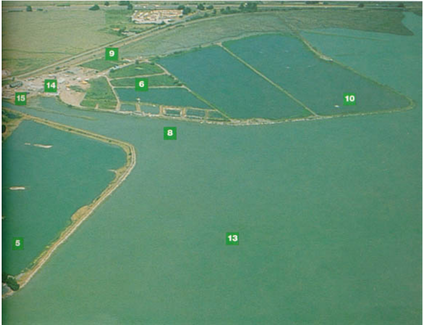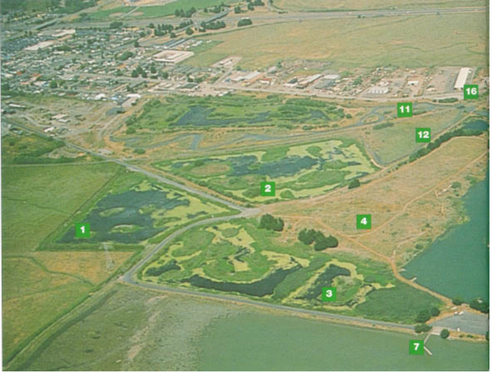Current Operations
The innovative wastewater treatment center established today in Arcata is the result of extensive community involvement and a series of political events. The cost effective constructed wetland system now offers the city a unique site for recreation and education, as well an “environmentally sound” wastewater treatment facility [7]. This system incorporates marsh plants, soils, and associated microorganisms to treat wastewater that meets federal and state water quality requirements [6, 7, 8].
Treatment Stages
There are several different treatment stages in the Arcata Wastewater Treatment Plant to clean the city’s effluent before the release of the water in to Humboldt Bay [4,6,7,8]. There are four major types of treatment that are achieved by multiple processes: primary treatment; secondary treatment; tertiary treatment; and disinfection.
Primary Treatment
The purpose of primary treatment is to remove suspended solids and oils from wastewater by sedimentation. This portion was completed in 1949.
- Headworks: The headworks are the first component of the wastewater treatment plant. The purpose of this phase is to remove inorganic material from the raw sewage. Technologies include two screw pumps that lift the sewage fifteen feet, pass it through bar screens, a parshall flume, and grit separators.
- Primary Clarification: Two clarifiers settle out the remaining suspended material that passes through the headworks. The liquid that is the result of clarification flows to the oxidation ponds, and the remaining solids settle out in the clarifiers and are pumped to the digesters.
- Digesters: The digesters mix the sludge by recirculating methane gas with compressors. The purpose of the digesters is to reduce the mass of the sludge and convert it into non-hazardous material that can be handled or used by minimal health hazards. This uses an anaerobic process: hydrolysis, where bacteria break down complex organic compounds; acidogenesis, where simple organic compounds form; and methanogenesis, or methane fermentation [4].
Secondary Treatment

Figure 7: 6) treatment marshes, 10) oxidation ponds [5].
The purpose of secondary treatment is to degrade the biological content.
- Oxidation ponds: The effluent from the primary clarifier is pumped to the oxidation ponds. This is where organic material is incorporated into large bacteria cells that settle on the bottom of the pond. Algae in the pond supply the oxygen for the bacteria to function [4]. The oxidation ponds remove approximately 50 percent of the BOD and suspended solids that are still present after primary treatment [7].
- Treatment marshes: There are three, two-acre treatment marshes that are located north of the oxidation ponds. The treatment wetlans were planted with Hardstem Bulrush, a native plant that is effective as a treatment species [7]. The biomass that is growing in the wetlands slows the rate of flow enough so the suspended solids settle on the bottom. The dense canopy that is created by a variety of plants, primarily Cattail and Hardstem Bulrush, allow a root network with surface area for micoorganisms to live. Anaerobic microoganisms convert nitrogen to ammonia and ammonium, and aerobic microorganisms convert ammonia to nitrite, which is taken up by the Cattails and Hardstem Bulrush [4,7,8].
Tertiary Treatment

Figure 8: 1) Gearheart Marsh, 2) Allen Marsh, 3) Hauser Marsh, 4) Mt. Trashmore [5].
Enhancement marshes: Water from the treatment wetlands is chlorinated and dechlorninated before enter the enhancement marshes. There are three enhancement marshes, which over 31 acres, located northwest of the oxidation ponds [8]. The three enhancement marshes were part of the initial area created by the City of Arcata to restore the land, they were named after the initial supporters of the wetlands construction.
- Allen Marsh: abandoned log deck
- Gearheart Marsh: former pasture land
- Hauser Marsh: barrow pit for the capped landfill, Mt. Trashmore
Water initially moves into the Allen Marsh, and then the Gearheart Marsh, and finally the Hauser Marsh. Flow is direted through the marshes with sluice gates and wooden stop-log weirs. Solids, nutrients, and BOD are further removed by bacterial consumption and plant uptake. In areas with sunlight algae grow while consuming nutrients and releasing oxygen. This cycle fuels the growth of bacteria, which continue to break down BOD. In the shaded areas, algae is unable to grow, thus there is no oxygen. These anaerobic areas have specialized bacteria can decompose dead plant and bacterial cells and release nitrogen into the atmosphere. Reeds that grow in the shaded portions of the marshes also incorporate phosphates and nitrates into their cells.
The net result of the enhancement marshes is to take the diluted BOD and nutrients and force them to sink to the bottom of the marsh so they do not float into the Bay. The effluent from the Hauser Marsh is pumped back to the disinfection facility.
The net result of the enhancement marshes is to take the diluted BOD and nutrients and force them to sink to the bottom of the marsh so they do not float into the Bay. The effluent from the Hauser Marsh is pumped back to the disinfection facility.
Disinfection
The wastewater is disinfected with chlorine gas before and after the enhancement marshes. After disinfected for the final time the water is discharged into Humboldt Bay. The disinfection takes place south of the headworks. Before the final effluent is released, any free chlorine remaining is removed with sulfur dioxide [4,7].

